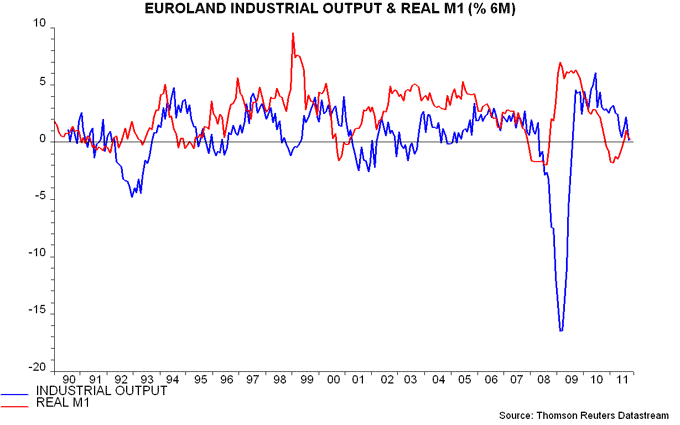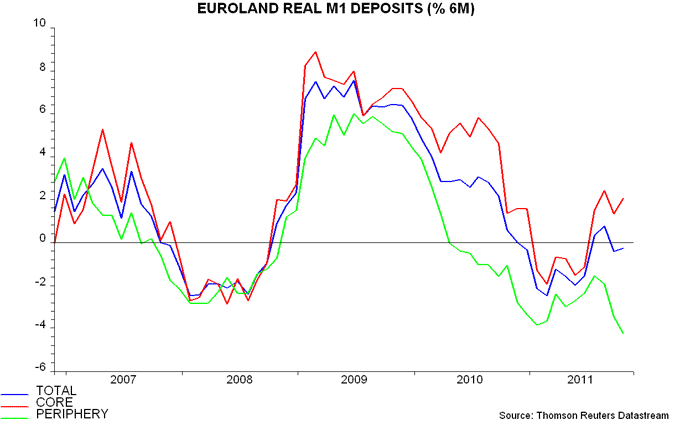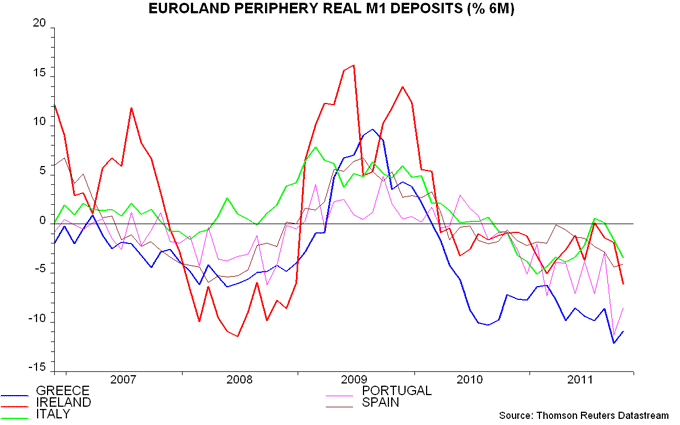Entries from November 27, 2011 - December 3, 2011
PMIs confirm global stabilisation
The G7 PMI manufacturing new orders index (i.e. a weighted average of country indices) rose for a second month in November, regaining the break-even 50 level, as suggested by a recovery in the world earnings revisions ratio discussed in a post last week. 
The revival confirms the forecast here that global economic weakness would abate in late 2011 in lagged response to faster real narrow money supply expansion. This forecast received earlier backing from less negative OECD leading indicator results – see here.
Better G7 new orders were driven by a large US increase and much smaller UK gain that offset further weakness in the Eurozone and a setback in Japan, the latter partly reflecting supply chain disruption caused by the Thai floods. (Thai manufacturing output plunged 35% between September and October.)

US economic outperformance is consistent with much stronger real money expansion in the US than elsewhere since the spring. Eurozone orders, however, typically follow those in the US so may have bottomed last month.
The pick-up in US orders accords with the historical pattern though has occurred slightly later than expected. This pattern suggests that the revival in momentum will be sustained in early 2012 – barring a negative shock from the Eurozone crisis or domestic policy errors (potentially including premature fiscal tightening).

Chinese economy resilient amid data confusion
Markets have been fretting about a Chinese “hard landing” following last week’s release of weak Markit manufacturing PMI results for November. The key new orders index plunged to 45.7 last month, revised to 45.0 today – the lowest since March 2009.
A post here, however, expressed scepticism about the Markit numbers, on the basis that they often diverge from the more reliable official PMI survey while the suggestion of weakness was at odds with a recent pick-up in a leading indicator derived from the OECD’s Chinese leading index. The post advised suspending judgement pending the official PMI results.
On the face of it, these results, released today, are weak, though less bad than the Markit survey – the new orders index fell to 47.8 versus Markit’s 45.0. The official numbers, however, display a seasonal pattern despite a claim that they are adjusted. Using Datastream’s seasonal adjustment procedure to remove this variation, the official new orders index actually rose marginally in November – from 51.1 to 51.3 (i.e. the fall in the headline index was less than normal for the time of year).


This firming accords with both the aforementioned leading indicator and a recent improvement in the balance of upgrades and downgrades to equity analysts’ company earnings forecasts – official PMI new orders correlate with the earnings “revisions ratio”.


There was additional good news in today’s official survey in the form of a drop in the input price index to below 50, suggesting a sharp slowdown in producer price inflation that will enhance prospects for further monetary easing following yesterday’s surprise cut in reserve requirements.

UK Autumn Statement: much ado about nothing
The vast coverage of the Autumn Statement is out of all proportion to its macroeconomic significance.
The Chancellor and the Office for Budget Responsibility (OBR) have, in effect, traded assumptions. The OBR has cut its guess about potential output, implying that a larger proportion of the current deficit is structural. The Chancellor has retaliated by assuming that he will be able to cut public spending by 0.9% a year in real terms in 2015-16 and 2016-17, thereby putting the structural budget position back on track. The various measures announced in the Statement, while possibly of merit, are too small to have a major impact on the economic and fiscal outlook.
It should be stressed that the OBR’s negative reassessment of the fiscal position reflects a downgrade to its estimates of current and future potential output rather than worse-than-expected recent borrowing outturns. This downgrade may or may not be warranted but it is troubling that the fiscal framework pivots on a concept subject to huge empirical uncertainty.
Aside from the further spending cut from 2015-16, the various measures announced in the Statement are essentially self-financing. The main short-term expansionary measures are a reduced rise in fuel duties (costing £975 million in 2012-13), an increase in infrastructure spending (£760 million), additional funding for the Youth Contract (£365 million), small business rate relief (£210 million) and a cap on rail fares (£105 million). The infrastructure boost rises to £2.145 billion by 2014-15 but this is still only 0.1% of GDP. The Chancellor, of course, hopes to tap pension funds to finance a more ambitious programme but delivery is uncertain.
The cost of these measures is met by capping child and working tax credit (raising £1.24 billion in 2012-13), changing the tax treatment of asset-backed pension contributions (£450 million), cutting overseas aid (£380 million) and raising the bank levy (£280 million).
The Chancellor took credit for the low level of gilt yields in his speech but Bank of England data released today suggest that QE2 and capital flight from the Eurozone have been the key drivers: the Bank essentially monetized the budget deficit in October, with purchases of £16.9 billion versus DMO issuance of £17.0 billion, while foreign gilt-buying surged to £12.5 billion – the highest since April 2010.
UK real money pick-up to support economy
UK monetary statistics for October suggest that widespread gloom about economic prospects is overdone.
Broad money, on the preferred M4ex measure, rose by a respectable £8.5 billion or 0.5% in October, partly reflecting Bank of England gilt purchases of £16.9 billion. This builds on an acceleration occurring before the launch of QE2: six-month growth has firmed to an annualised 4.5% with the year-on-year increase up to 2.8% – the highest since June 2009.
A broader liquidity aggregate including private sector holdings of Treasury Bills, National Savings instruments, DMO repos and foreign currency deposits at UK banks is growing more strongly than M4ex – an annual 4.1% in October.
Corporate liquidity is improving: M4 holdings of private non-financial corporations rose by an annualised 9.0% in the latest three months.
Better nominal monetary trends combined with slowing inflation will lead to a significant acceleration in real money expansion by early 2012, boosting growth later next year. The view here is that an inflation squeeze on real money was a major reason for this year’s economic weakness.
The Bank essentially monetized the budget deficit in October – bond purchases of £16.9 billion compared with DMO net issuance of £17.0 billion. Capital flight from the Eurozone continued to boost the gilt market, with overseas investors buying £12.5 billion – an 18-month high. Banks, meanwhile, purchased by £2.7 billion, with the non-bank private sector acting as “seller of last resort”, reducing holdings by £16.7 billion.
Eurozone money numbers confirm peripheral slump
Eurozone monetary statistics for October are weak but the bigger story is a widening core / periphery divergence, with an accelerating decline in real M1 deposits in the latter group suggesting that economies remain locked on course for a depression barring radical ECB action.
M1 – comprising currency in circulation and overnight deposits – is a better leading indicator than the broader M3 measure, probably because households and firms increase their holdings of more liquid forms of money before raising spending. The six-month rate of change of Eurozone-wide real M1 turned negative in late 2010, warning that a recession would develop during 2011. The six-month change has since returned to positive territory but remained weak at just 0.3% (0.5% annualised) in October – see first chart.
The ECB publishes a country breakdown of overnight deposits but not currency. Region-wide real M1 deposits fell by 0.3% in the six months to October but this conceals a 2.1% rise in core economies (i.e. Germany, France, Netherlands, Austria, Belgium, Luxembourg) offset by a record 4.2% decline (8.3% annualised) in the periphery (Italy, Spain, Greece, Portugal, Ireland) – second chart. Peripheral weakness partly reflects capital flight into the core or out of the euro area altogether but this does not alter the economic implications – money leaving M1 accounts will not be spent domestically.
The annualised fall in the six months to October was 20.7% in Greece, 16.3% in Portugal, 11.8% in Ireland, 8.1% in Spain and 6.7% in Italy. The Portuguese reading confirms that last month’s slump was no fluke while Irish and Italian numbers have deteriorated markedly since the summer, when there were tentative signs of real M1 deposits stabilising – third chart.




